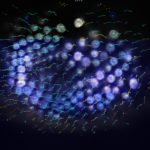Link to Pubmed [PMID] – 27332860
Link to DOI – 10.1371/journal.pone.0150853
PLoS One 2016 ; 11(6): e0150853
Many questions in developmental biology depend on measuring the position and movement of individual cells within developing embryos. Yet, tools that provide this data are often challenged by high cell density and their accuracy is difficult to measure. Here, we present a three-step procedure to address this problem. Step one is a novel segmentation algorithm based on image derivatives that, in combination with selective post-processing, reliably and automatically segments cell nuclei from images of densely packed tissue. Step two is a quantitative validation using synthetic images to ascertain the efficiency of the algorithm with respect to signal-to-noise ratio and object density. Finally, we propose an original method to generate reliable and experimentally faithful ground truth datasets: Sparse-dense dual-labeled embryo chimeras are used to unambiguously measure segmentation errors within experimental data. Together, the three steps outlined here establish a robust, iterative procedure to fine-tune image analysis algorithms and microscopy settings associated with embryonic 3D image data sets.


